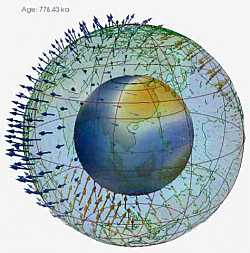The first target for the paleomagnetic search of intermediate field directions were the Pleistocene and Pliocene volcanic rocks from South-East-Austria (Styria). 28 sites were sampled on eight Pliocene volcanoes of which four gave paleo-directions and intensities in the range expected from secular variation. The remaining 4 volcanoes have low paleo-inclinations and intensities. A transitional geomagnetic field configuration was recorded during the short eruptive activity of these volcanoes. Two new 39Ar-40Ar ages allow the correlation of the Styrian transitional directions with cryptochron C2r.2r-1 of the geomagnetic polarity time scale. As a cryptochron has a short duration of less than 10 to 30 ka, at least 4 of the investigated 8 Styrian volcanoes have been formed in a much shorter time interval than previously suggested. Results are published here . The second sampling campaign was conducted on island São Nicolau (Cape Verde) in October 2018. According to Duprat et al. (2007) the island is built up by basalts of predominantly late Miocene to Pleistocene age. We sampled three promising sections containing field reversal, but did font find transitional directions. A publication on secular variation is in preparation. Finally, a third sampling campaign on St. Helena was undertaken. We sampled in detail and expanded a section already investigated by our collaborators in Liverpool in which a field transition is recorded. Additionally, one other section with mixed polarity was sampled. Most of the obtained paleointensities are considerably lower than the present day or the dipole field intensity. During the polarity transition a drop in the field strength is apparently not present. Although we could discover transitional geomagnetic field directions in two of the projected three volcanic provinces modelling of the geomagnetic field during a field transition is hampered.
Geomagnetic Field Reversals



